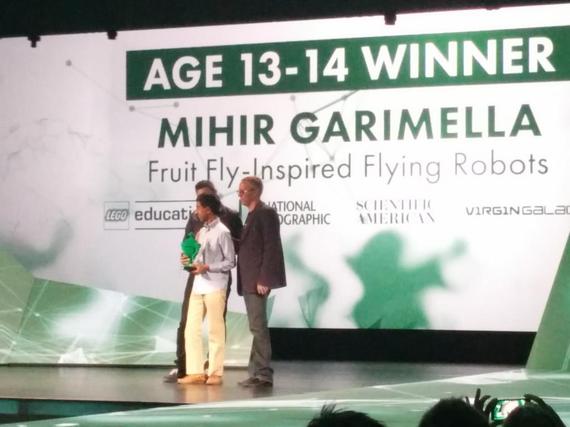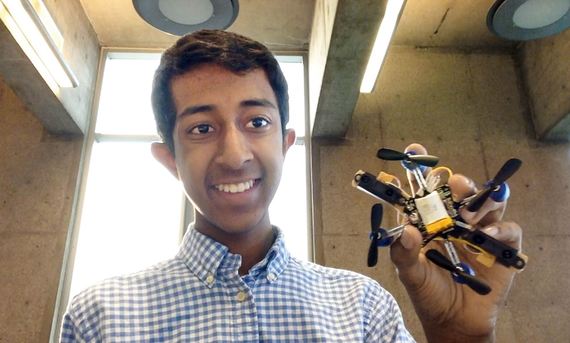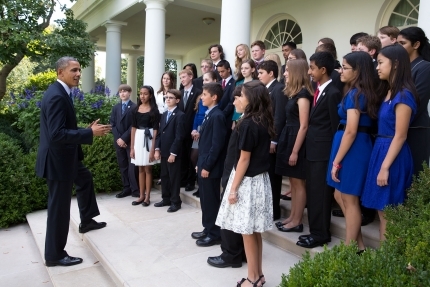When you see a fruit fly, generally, the next thing you think of is a broom or book to swat it. But when Mihir sees a fruit fly, he thinks of his Google Science Fair Award and how the flies inspired him.
November 10 is World Science Day for Peace and Development and in course of this stroll, Mihir and I discussed his flying robot, Biomimicry, and his aspirations for the future. Meet this 14-year-old genius:
Ebenezar: Hello Mihir, it's great to have you the stroll.
Mihir: Thanks for inviting me, Ebenezar!
Ebenezar: How has it been for you after the Google Science Fair? I strolled with Ciara, Emer, and Sophie last month and they told me how they plan to adjust to the attention and fame, and also focus on school. So how have you been adjusting?
Mihir: The Google Science Fair was an amazing experience, and one that I'll never forget, but I'm keeping up with my school work now. I've been especially busy as a result of the Google Science Fair -- last week I presented at a conference on unmanned aerial vehicles, and this week I'm going to be a keynote panelist at another conference -- and my teachers have been very accommodating in adjusting my workload and schedule.
Ebenezar: Awww, that's nice.
Mihir: Yeah, they've been very nice. As far as my project goes, I'm currently working on applying my work to help make search and rescue missions or emergency response carried out by flying robots truly autonomous. I'm really excited about those applications in particular because I think that they have the potential to save a lot of lives and have an immediate impact, and I hope to use the funding and mentorship from my Computer Science Award to make this a reality.
Ebenezar: Okay, you were highest in the 13-14 category and also winner of the new Computer Science category. That's a really great feat I must say, so when did you start programming?
Mihir: I started programming when I was seven or eight. I first learned a language called Visual Basic, and I've been teaching myself new languages ever since. In particular, I've been interested in applying programming to robotics. When I was young, I had a robotic dog that could bark and move and interact with its environment. It quickly became my favourite toy, and showed me that, through this relatively simple combination of hardware and software, you could quite literally bring something to life.
Ebenezar: Do you consider yourself a nerd? Because programmers are generally seen as nerds, you know?
Mihir: I love computer science and robotics, but I also love playing sports and hanging out with my friends, so I guess it depends on how you define "nerd." However, being a nerd isn't inherently a bad thing; Bill Gates once said, "Be nice to nerds [because] chances are you'll end up working for one," and he was right, in that nerds really have the power to change the world.
Ebenezar: Yeah right? they do. Okay, let's talk more about your flying robot now. Word out there says you got the inspiration from fruit flies? Can you tell us a bit about this?
Mihir: Sure. Last summer, when my family went to India on vacation, we left bananas on the kitchen counter. We returned to find our house filled with fruit flies. I kept trying to swat them and I became really frustrated, but I also started to realize how amazing the fruit fly's escape is, especially given how tiny they are. In particular, I had been reading about flying robots at them time, and one thing that struck me was the similarities in the environments in which both fruit flies and flying robots have to operate, and the challenges that go along with those environments. I wanted to see whether we could draw from biology, and particularly the marvel of fruit fly escape, to improve these flying robots, and to help make them truly autonomous.
Ebenezar: I'm also a biomimicry enthusiast (or wannabe biomimic) and early this year in my stroll with Dr. Tamsin Woolley-Barker on World Wildlife Day, we talked about how nature is filled with lessons for all us to learn. Will you advise more scientists to look to nature for inspiration?
Mihir: Absolutely. Nature is a really great model for innovation because it's already solved many of the problems that scientists and engineers are trying to solve now, often in simple but effective ways that have been perfected by millions of years of evolution. I think that my project is a testament to the power of a biologically-inspired, lightweight approach to solving problems, and I would definitely encourage scientists to look to nature for inspiration; in my mind, it's the natural thing to do.
Ebenezar: Apart from the invention of the flying robot, are there other lessons you've learnt from nature which you'd like to share with us?
Mihir: This summer, I worked at Carnegie Mellon University's Robotics Institute, creating a lightweight method of navigating and mapping environments using a single low-resolution camera. Rather than using a laser scanner or stereo camera to get depth information, the algorithm that I created efficiently extracts three-dimensional information from a series of two-dimensional images by drawing inspiration from how animals (particularly birds and lizards, because their eyes are on opposite sides of their heads and so there's not a lot of overlap in what they see) perceive their environments. In general, I'm really excited about how we can look to nature to solve problems in robotics and computer science, and in science as a whole.
Ebenezar: So, November 10th is World Science Day for Peace and Development, and one reservation people have about science is the fact that the power that comes with science sometimes can be very hard to tame, and when science turns negative, it can be very fatal. Is it possible to restrict people to use science only for positive purposes?
Mihir: I don't think it's possible to restrict science, or anything, really, to be used for only positive purposes. However, in general, I think that science is the only way to move the world forward. It's easy for us to take what we have for granted, but without science we wouldn't be where we are today. The world isn't perfect, and we need to keep improving it; science is a really effective way to do this, and on the whole it's incredibly beneficial.
Ebenezar: Who are some of your role models and mentors?
Mihir: My parents have always been my biggest role models. They encouraged me to ask questions, to question how the world works and think about how it could be improved. They also taught me to build things, to dig in to problems and try to solve them. In general, they shaped how I see the world and how I think about solving problems.
IEbenezar: I know this is a cliche question but for a 14 year old who is already doing great things, I think it is necessary. What will you like to be when you grow up?
Mihir: The future is open for me; I might become a researcher or start a company. I'm not sure exactly what I'll work on, but I do know that I want to use computer science and robotics to solve problems and make a difference.
Ebenezar: Do you have any advice for kids and teens listening right now?
Mihir: My biggest piece of advice to kids is to never stop asking "why?," and to find a question that you're really passionate about and work relentlessly to answer it. Science is hard work and things often won't go as well as you hope--for my Google Science Fair project, I spent nearly four months designing and building prototype after prototype of the sensor module before I had something that worked--and if you pick something that you love, you'll be motivated to stick with it
Ebenezar: Many thanks for coming on the stroll bro, I wish you all the best in your future pursuits.
Mihir: You're welcome Ebenezar, thanks.
___________________________________
For more about Mihir, visit mihirgarimella.com
(Images Credit: Google Science Fair; Mihir Garimella; Jerret Zaleski; Broadcom Foundation)
Thought to Remember: "You lazy people can learn by watching an anthill." (Proverbs 6v6, CEV)
This stroll was done by Write Paragraphs to OBSERVE World Science Day For Peace and Development 2014




